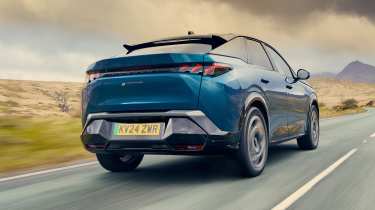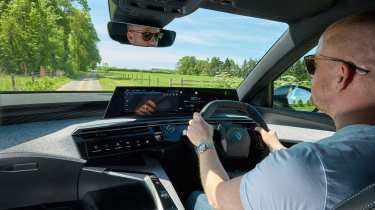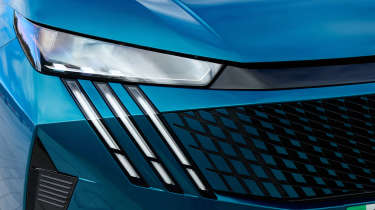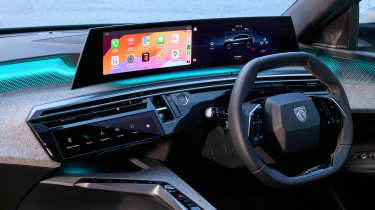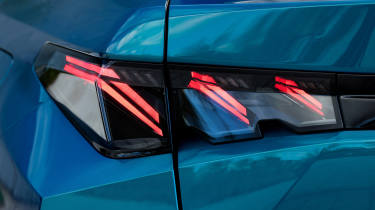Peugeot E-3008 review
Peugeot’s latest electric SUV boasts a strikingly futuristic interior and promises class-leading range, but many rivals offer better value-for-money
Pros
- Striking looks inside and out
- Comfortable
- Pretty spacious
Cons
- Stingy kit list in some areas
- Vague steering
- Expensive
Peugeot E-3008 verdict
The new Peugeot E-3008 looks sharp on both the inside and outside as well as providing a decent helping of efficiency and space. However, although it stands out visually, this particular electric SUV fails to offer anything that really puts it ahead of the competition.
The cabin is a very lovely place to sit, but the incredibly firm ride takes away from an otherwise comfortable ambience. This wouldn’t be quite as bad if the upside was an engaging driving experience with strong performance, but the E-3008 doesn’t really offer these, either. In fact, things start to feel rather sluggish as soon as you top 30mph. Don’t get us wrong, the Peugeot E-3008 isn’t a terrible car, but it isn’t a great one either.
Details, specs and alternatives
It’s taken a while for Peugeot to fully electrify its 3008 family SUV, but at last the Peugeot E-3008 is here. It brings with it a fresh futuristic design and an all-new EV platform that’s also set to underpin future Stellantis group models like the next-generation Vauxhall Grandland.
This French lion finds itself in a den full of fiercely competitive rivals, having to fend off the likes of the Skoda Enyaq, Renault Scenic and Tesla Model Y. Buyers may also be considering smaller models like the Hyundai Kona Electric and Kia Niro EV as well as, given the Peugeot’s rather premium price point, posher offerings like the BMW iX1 and Audi Q4 e-tron.
As mentioned, the Peugeot E-3008 sits on an entirely new platform and is also available in hybrid form. We’re all about BEVs here at DrivingElectric, though, so it’s the fully-electric E-3008 we’ll be focusing on here. For now this is only available in entry-level ‘210’ guise, this is powered by a 73kWh battery that’s paired to a front-mounted 210bhp electric motor. With this setup, the E-3008 has a maximum claimed range of up to 327 miles and will dispatch 0-62mph in 8.8 seconds – not exactly remarkable figures, but competitive nonetheless.
Perhaps more exciting is the forthcoming ‘230 Long Range’ version which truly lives up to its name through a claimed 435-mile maximum – more than a Tesla Model 3 and about the same as a Fisker Ocean. If riotous performance is more important to you than range, Peugeot is also releasing a ‘310 Dual-Motor’ E-3008 later this year which, as its name suggests, gets two electric motors to provide four-wheel drive and a punchy 316bhp.
For now, it’s just the ‘210’ on sale, which is available in two trim levels: Allure and GT. The former is generally well-equipped, bar a few disappointing omissions. As standard, the E-3008 gets LED lights front and rear, 19-inch diamond-cut alloy wheels, a 21-inch digital instrument cluster and touchscreen infotainment system, dual-zone air conditioning, part-leatherette upholstery and a reversing camera.
Annoyingly, if you want heated seats or adaptive cruise control, you’ll have to step up to the range-topping GT trim as neither are available as an option on the Allure. with top-of-the-range E-3008 models demanding a roughly £4,000 premium. For your extra cash, you do also get larger 20-inch alloys, Pixel-LED headlights, Alcantara upholstery, extended ambient lighting and front parking sensors.
This being the case, unless you’re really set on having a toasty bottom, we recommend saving your cash and sticking with the Allure. That said, we would also recommend splashing out an extra £700 on a heat pump – a somewhat cheeky exclusion from the standard kit list and, we think, a necessary item given how cold it can get at winter time here in the UK.
Range, battery size & charging
| Model | Range | Wallbox charge time | Rapid charge |
| 210 | 327 miles | 10hrs 30mins (0-100%, 7.4kW) | 30mins (20-80%, 160kW) |
According to Peugeot, the E-3008 is capable of up to 435 miles on a single charge under the official WLTP testing conditions. However, that’s only when equipped with the larger 90kWh (usable) battery that’s found on the ‘230 Long Range’ model which is arriving in late 2024.
Only the entry-level ‘210’ model is available in the UK for the moment and this gets a more modest 73kWh battery. This unit still claims up to 327 miles of range on a single charge, though, which is roughly the same as a Tesla Model Y Long Range. However, this is also around 50 miles short of the cheaper Renault Scenic E-Tech. A ‘230 Twin-Motor’ model is also arriving further down the line, and this will have the same battery and range figure as the less-powerful, single motor 210.
We managed an average of 4.2mi/kWh from the 73kWh battery when testing the E-3008 on smaller roads. This is a respectable figure as it would result in a real-world range of 307-miles, which is very close to the official number.
In order to help boost efficiency, Peugeot’s ‘E-Route’ navigation system can calculate the most economical route when taking a longer trip. The software takes the total distance, remaining battery range, charging locations and live traffic conditions into account when making its calculations, and it should prove to be a useful bit of kit. You will need to connect a phone to the car’s infotainment system in order to use it, though.
On the subject of charging, the Peugeot E-3008 occupies the middle of the pack in this regard; a maximum DC ultra-rapid charging speed of 160kW should provide a 20-80% top-up in around half-an-hour, provided you find a suitable public charger. It’s worth noting that the Hyundai Ioniq 5 can complete the same charge in as little as 18 minutes thanks to a faster 220kW maximum charging speed.
Hooking up to a typical 7.4kW wallbox at home should see the 73kWh battery charged up in around ten and a half hours. The upcoming 90kWh models should take around 12.25 hours.
Running costs & insurance
Starting from around £46,000, the E-3008 is a chunk more expensive than an entry-level Renault Scenic, even though this has more range than the Peugeot. That said, the E-3008 beats the Tesla Model Y RWD on price, even when you compare the top-spec GT model with the Model Y Long Range.
In terms of running costs, the Peugeot E-3008 – like all electric cars – is zero-rated for VED road tax until 2025. It also sits in the lowest 2% Benefit-in-Kind tax bracket, making it a tempting choice for company car drivers. Insurance premiums, as is often the case with electric cars, aren’t exactly cheap. The entry-level Allure models sit in insurance group 32, with the GT sits slightly higher in group 33.
Charging the Peugeot’s 73kWh battery at home should cost around £22 at a typical rate of 30p per kWh. The larger 90kWh pack will set you back around £27.
Performance, motor & drive
| 0-62mph | Top speed | Driven wheels | Power |
| 8.8s | 105mph | Front | 210bhp |
Most buyers of a family SUV such as the Peugeot E-3008 typically don’t care so much about pushing their car to the limits, and the French maker has certainly kept that in mind when it comes to its own offering.
Despite its rakish squared-off steering wheel, the only sporty thing about the E-3008 is its very firm ride. Yet there’s no real benefit in terms of performance or driver engagement.
The single motor’s 207bhp and 345Nm of torque are pretty middling figures on paper, and this translates to real life, too. The E-3008’s accelerates in a pretty energetic manner until you reach the 30mph mark, then the urgency fades away as you get closer and closer to motorway cruising speeds.
0-62mph takes a rather unexceptional 8.8 seconds. It’s not slow by any means and, given the instant torque that’s inherent with electric powertrains, even feels rather nippy at lower speeds. The four-wheel drive Twin-Motor model with over 300bhp and a 0-62mph time of 6.4 seconds is coming soon if you’re after a little more poke.
The aforementioned steering is heavier than most Peugeot models, but the E-3008 is still pretty easy to manoeuvre in tight car parks as well as around town. Of course the caveat of this is that there isn’t a huge amount of feedback; it’s an easy car to place on the road, though, and the firm ride means body roll is kept in check.
Hard suspension aside, the Peugeot's overall refinement is very good, with wind and tyre noise being kept to an absolute minimum.
Interior, dashboard & infotainment
Undoubtedly the Peugeot E-3008’s biggest draw is its futuristic, second-generation i-Cockpit interior. This cocoons the driver with a sweeping 21-inch screen that combines the infotainment touchscreen and the instrument cluster. It’s a superb-looking and highly responsive system.
The acres of screen real estate aren’t fully exploited by Peugeot’s software – wireless Apple CarPlay and Android Auto come as standard if you’d rather use your phone – however, there is a small additional screen mounted below which at least provides easy access to the most important vehicle functions.
In terms of materials, the E-3008 utilises lots of soft-touch fabric on the dashboard and door cards to provide a premium, yet futuristic aesthetic. Some glossy black plastic has burrowed its way into the mix – unfortunate, given what a magnet it is for fingerprints and scratches – but generally, the quality is very good.
Boot space, seating & practicality
| Length | Width | Height | Boot space (seats up/down) |
| 4,542mm | 1,895mm | 1,641mm | 520/1,480 litres |
While the E-3008’s cabin may be exceptional in almost every respect, one area in which it’s not quite a class-leader t is in terms of space. It is a pretty roomy car – four six-foot adults will have no problem getting comfortable, despite the sloping roofline – but a Skoda Enyaq or Renault Scenic are both better choices for outright roominess and family-friendly features.
The same goes for the Peugeot’s 520-litre boot which is more than sufficient for a pair of large suitcases, a pushchair, or the whole street’s weekly shop, but some rivals have the E-3008 trumped when it comes to usable capacity. Unlike the Tesla Model Y, the Peugeot E-3008 is also without a ‘frunk’ under the bonnet, meaning you’ll most likely have to store your charging cables underneath the boot floor, reducing the overall volume somewhat.
Reliability & safety rating
We’ve very little to go off of in terms of how safe and/or reliable the Peugeot E-3008 will be as it’s such a new car, however, there are some indicators; Peugeot placed a pretty punchy ninth out of 32 manufacturers in our most recent Driver Power customer satisfaction survey, with roughly 19% of owners reporting a fault with their car within the first year of ownership – about average across all the included manufacturers.
It’s also worth noting that EVs should, in theory, be more reliable than the equivalent petrol model given they have fewer moving parts to go wrong.
The Peugeot E-3008 should be pretty safe, too; it comes with all the active safety and driver assistance systems you’d expect including autonomous emergency braking, lane departure warning.


